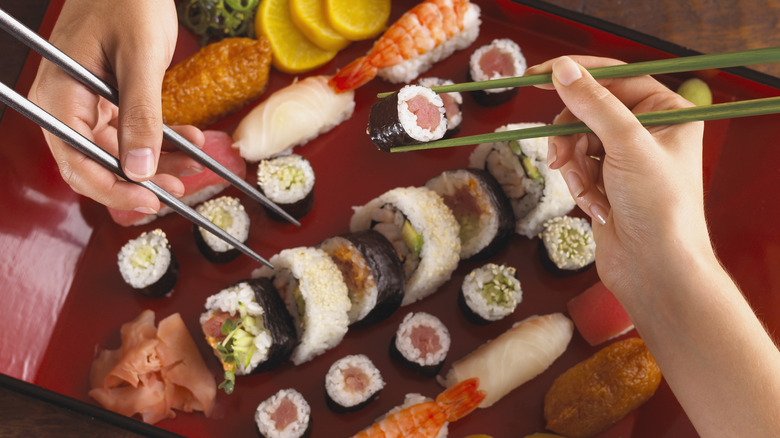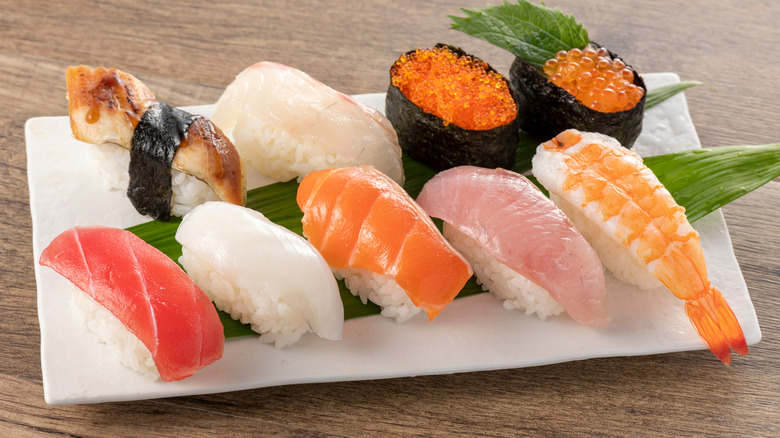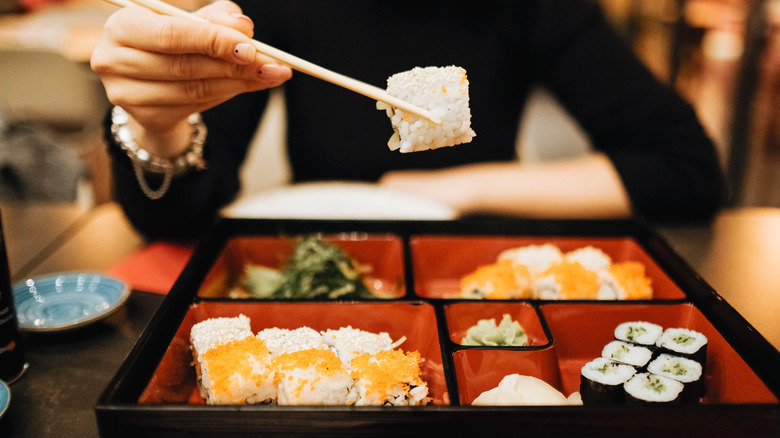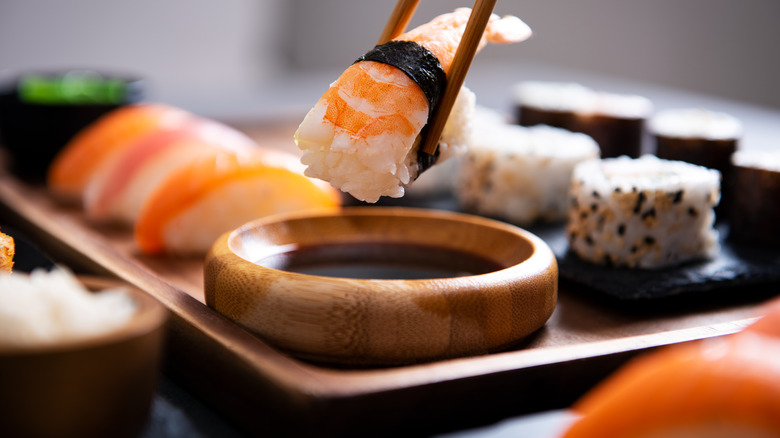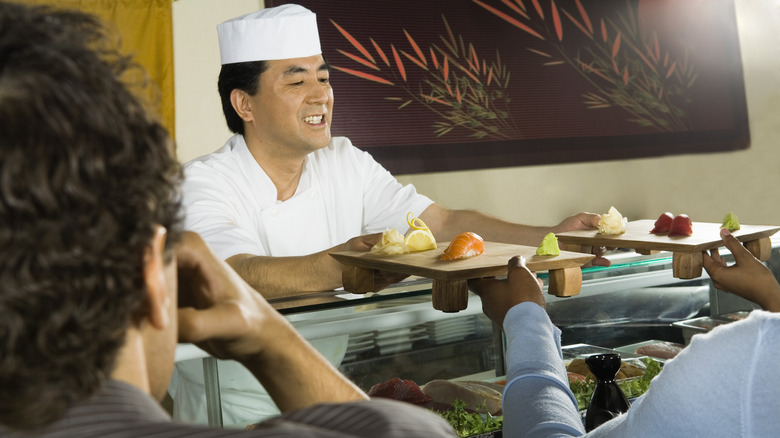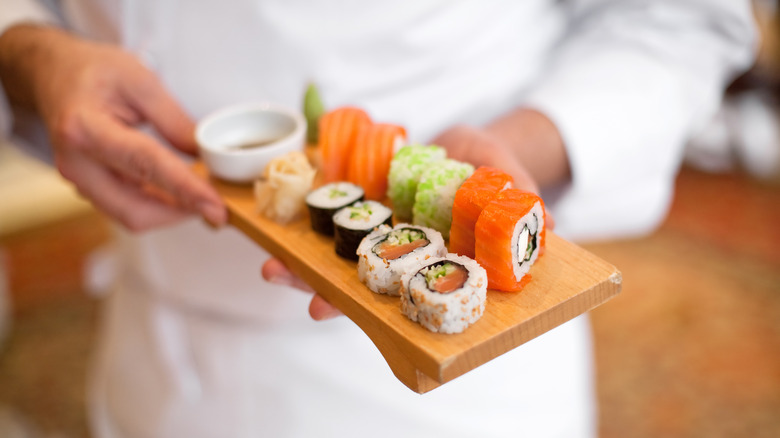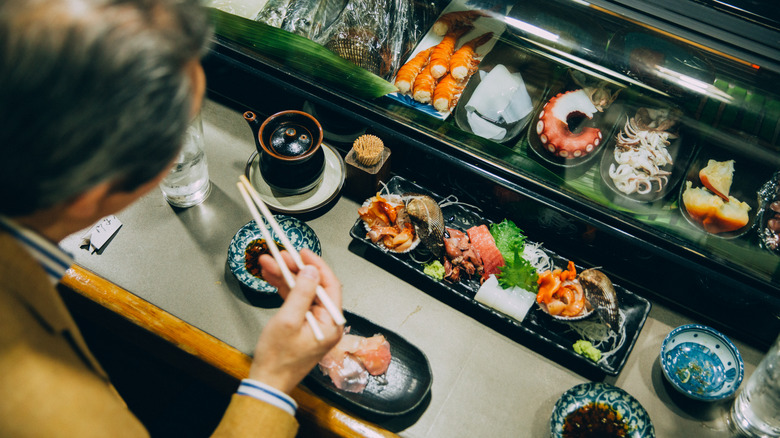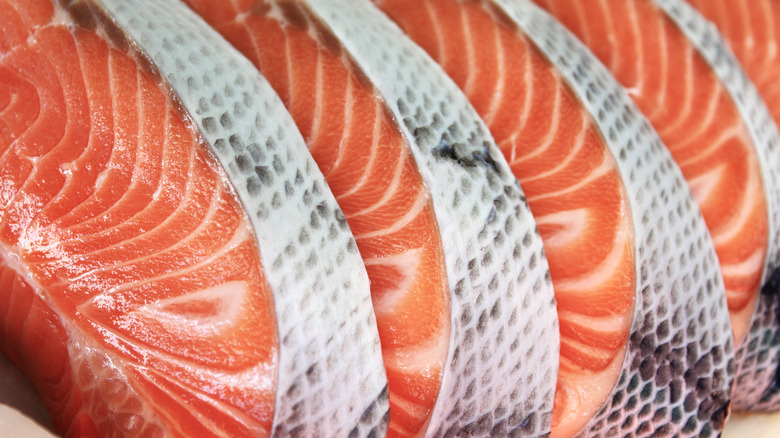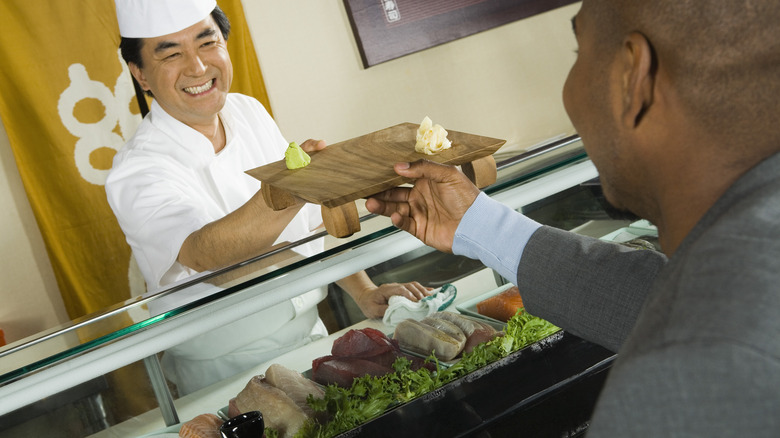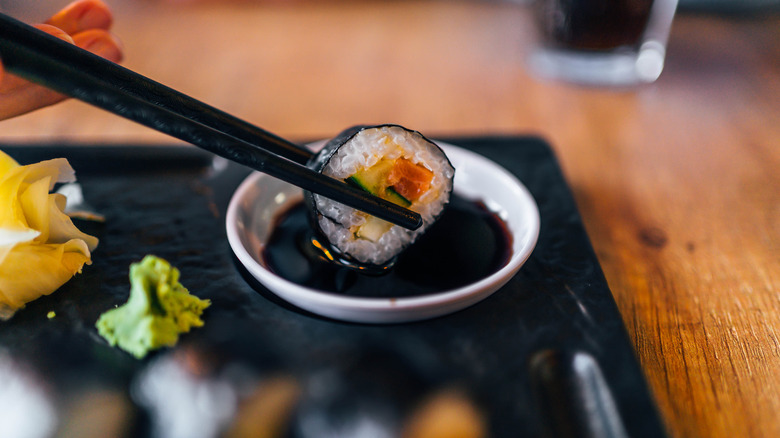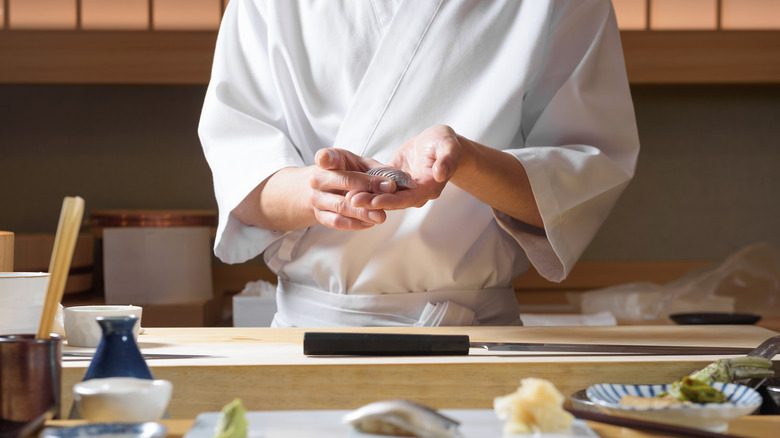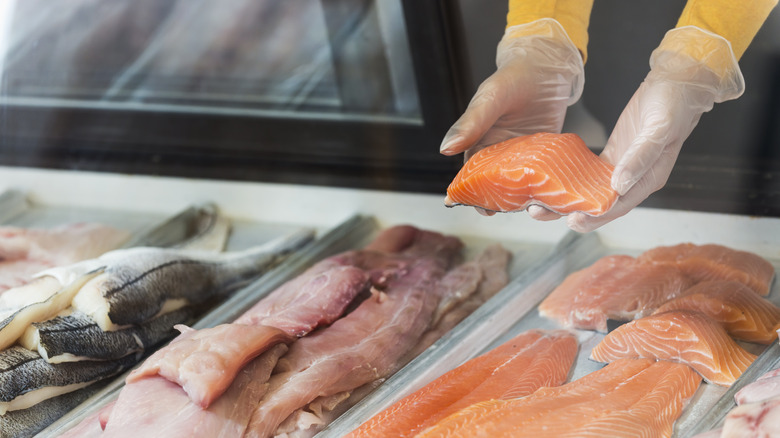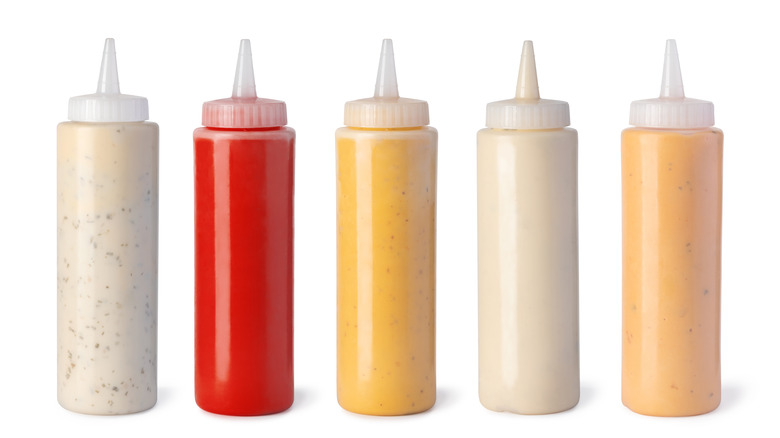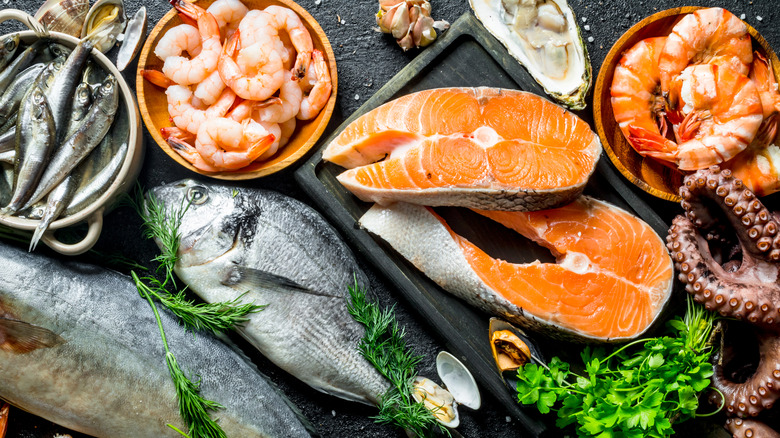All Your Sushi Questions, Answered
Like tacos or spaghetti, sushi is a dish with deep roots elsewhere that Americans have embraced and made their own — and American sushi lovers can satisfy their cravings everywhere from supermarket takeout counters to high-end traditional restaurants where trained chefs prepare each piece to order. We've even leaned into our national tendency to make everything bigger, bolder, and louder by concocting homegrown sushi variations such as California rolls and rolls featuring ingredients such as cream cheese and lox. (Yes, these are ours alone — if you try to order a California roll in Tokyo, you'll most likely get a blank stare.)
Despite its ubiquity, for many diners sushi still has a mystique surrounding it. Some may struggle with the idea of eating raw fish. Others may be curious to venture beyond supermarket and food court sushi, but don't know what to expect — or how to behave — at a traditional sushi bar. And others may have read about pricy restaurants with weeks-long waiting lists and wondered if the average diner could even taste the difference. Have no fear: You don't need to know a secret handshake or undergo a special initiation to appreciate sushi the right way — a little knowledge is all you need. Here's the essential information you need to become a sushi maven.
How safe is eating raw fish?
We often think of sushi and raw fish as fundamental elements of Japanese cuisine and culture. But in reality, sushi is a relatively new innovation in terms of Japan's long history, only becoming popular in the 19th century. And sushi featuring raw fish only became widespread when refrigeration did, in the 1930s. And while Japanese diners quickly embraced it, American and European diners initially found the idea off-putting, if not outright dangerous — at one point, the United States Embassy warned American visitors to Japan to stay away from raw fish. And even today, the USDA officially advises against eating raw fish, which can carry potentially dangerous parasites and bacteria.
Still, sushi is regularly consumed and most diners enjoy it without problem. So exactly how safe is it? The good news is that marine fish, the only types used in sushi, are inherently less prone to carrying parasites than freshwater fish. However, any fish can transmit a bacterial infection if not properly handled and kept at a consistently cool temperature. Most fish used in sushi in the U.S. has been flash-frozen to kill off any parasites before serving, and farmed salmon and tuna — some of the most commonly used fish in sushi — are considered relatively parasite free. Still, to be on the safe side, young children, the elderly, and those who are pregnant or have weak immune systems should stick to vegetarian and cooked-fish sushi preparations.
What are the basic sushi types?
When visiting a traditional sushi restaurant for the first time, the menu can seem daunting. You're likely to see a lot of unfamiliar Japanese terms and unfamiliar types of fish, and while this opens up a world of options, it can also result in decision paralysis if you're not prepared. Fortunately, the possible sushi inventory isn't as complicated as it seems. There are just a few basic varieties you need to familiarize yourself with to navigate a menu with ease.
The simplest item you'll encounter is sashimi, which is simply sliced raw fish, served by itself without rice. Nigiri consists of small, thin slices of fish on top of a lozenge-shaped mound of rice; this is the oldest and most traditional variety of sushi. Maki is the variety familiar to most Americans — rolled sushi with seaweed on the outside. You can also find the reverse: Uramaki is a sushi roll with rice on the outside and seaweed rolled inside. If any of the fish varieties on offer are unfamiliar to you and you have questions, just ask — both sushi chefs and waitstaff at serious sushi restaurants will be happy to share their insights and recommendations.
How much does high-quality sushi cost?
When visiting a high-end traditional sushi restaurant for the first time, one thing you might experience is sticker shock — you might find yourself paying hundreds of dollars for a meal that may set you back $50 at a conveyer-belt sushi joint. Indeed, the most expensive sushi restaurant in the United States is Masa, where a sushi meal can cost more than $1,000 per person, and that doesn't include drinks. This raises a couple basic questions: Is it worth it? And is this crazy pricing necessary?
There are plenty of reasons why high-end sushi requires an investment. For one, the chefs who make it are highly trained – apprentices in traditional sushi restaurants work three years before they're even allowed to touch any fish. And top chefs are perfectionists, making rice to order, slicing fish by hand, and carefully hand-shaping each piece to ensure the rice is neither too dense nor too loosely packed. The quality of the ingredients also adds to the price — top sushi restaurants choose only the freshest, most seasonal fish obtained from trusted purveyors. And high-end presentation comes at a cost: At the exclusive restaurant Sawada in Tokyo, the counter on which sushi pieces are presented to diners is made of hinoki wood, a variety once reserved for emperors' coffins — and is meticulously planed to reveal a fresh surface after each meal service.
How long should I wait to eat sushi?
With all the attention and care that goes into making high-quality sushi, appreciative diners might want to savor the experience. For most of us, it'll be a special-occasion meal and we'll want to not only enjoy every minute of it, but make the experience last as long as possible. And serious food lovers who've experienced wine tastings or coffee cuppings are conditioned to enjoy special flavors slowly and intentionally, taking the time to absorb every nuance they offer. Such attention, we've been taught, not only enhances our experience, but is a way of honoring those who made our food and drink.
While sushi chefs appreciate your respect for their work and their ingredients, however, what they really want is for you to eat their creations as soon as they're placed in front of you. Freshness is everything for these chefs, and there's a reason they cut and shape your sushi only after you ordered it — to ensure you'd experience the just-cut fish and newly-prepared rice at their best. So once your chef serves you, go ahead and eat. Avoid nibbling — sushi is meant to be eaten in one or two bites.
Is sushi served cold?
Many of us are so used to picking up boxes of pre-made sushi from refrigerated cases that we assume sushi is supposed to be served chilled. This would make sense, since raw fish is supposed to be stored cold ... it would follow that your sushi would be cold too. However, if you go to a traditional sushi restaurant, you won't find ice-cold sushi. The fish itself, if raw, may be cool or cold, but the rice may actually be slightly warm.
And yes, it's supposed to be that way. Sushi chefs want their rice, like their fish, to taste fresh, which means using it shortly after it's cooked and just above room temperature, while it's still tender and toothsome. Cold rice, in contrast, is drier and tougher (or just as bad, mushy if initially overcooked) – not textures you want in a bite of sushi. Chilling also dulls flavors, including the flavor of freshly cooked rice, and sushi chefs pay as much attention to the flavor and texture of their rice as to their fish.
Is there an order to how I eat sushi?
If you love sushi, it's easy and satisfying to make a whole meal of it. While many restaurants offer full sushi sets with fixed assortments, some diners prefer to order a la carte to ensure their meal includes all and only their favorites. Another fun option offered by some traditional sushi restaurants is omakase, or chef's choice, in which you let the chef choose your menu for you. And while all of these options may appear to offer an unstructured parade of different sushi types that you can eat at will, there is actually an optimal order in which to taste them.
The basic principles for enjoying a sushi meal are pretty much the same as those for a structured wine or cheese tasting: Start with the mildest, most delicately flavored varieties first and work your way up to the more powerfully flavored ones. This ensures that you can best appreciate the flavors of each without the previous bite overwhelming the next. In the case of sushi, this means starting with white-fleshed fish before moving on to tuna and then to strongly flavored items such as uni (sea urchin). If the chef is preparing your sushi as you eat and sending out plates one at a time, eat everything in the order it's presented — it's being sent out in that order for a reason.
What does the term sushi-grade mean?
Sushi has become so commonplace that most of us assume that the fish in any sushi we buy will be of acceptable quality. But when we consider making our own sushi, we're a lot pickier — while we assume the supermarket fish in our grab-and-go sushi is safe, few of us would consider grabbing any old piece of fish from the store and taking it home to make our own sushi or sashimi. Instead, the intrepid few of us who want to try making their own seek out fresher, higher-quality fish, often labelled "sushi grade" or "sashimi grade."
However, these terms don't mean anything. There's no such thing as an official grade or set of standards for sushi-suitable fish. Instead, "sushi grade" and "sashimi grade" are informal terms used by sellers to indicate that they've deemed the fish safe to eat raw – and how reliable that judgement is depends on the expertise and integrity of the person making it. So if you want to prepare your own sushi or sashimi at home, your first move should be to find a reputable fishmonger. If possible, buy whole fish rather than fillets (since it's easier to assess the freshness of whole fish), keep it cold until you use it, and be sure all knives and other equipment you use to prep it are clean.
Is it okay to eat sushi with my hands?
It's a familiar scenario: A lovely platter of sushi has been placed before you. You grab your chopsticks, carefully pick up a piece, hoping not to break it apart in transit, dip it in soy sauce, and take a bite — only to have half the rice and filling fall onto your plate in a cringy mess. It makes you feel ungraceful, but you power through and repeat with your remaining sushi.
It's not supposed to be that hard. In Japan, sushi is traditionally meant to be eaten with one's fingers – this is why most traditional restaurants offer hot, moist hand towels to guests before each meal. For example, to enjoy a piece of nigiri — sushi with slice of fish atop an oval of rice — pick it up, and if you want to add soy sauce, dip a bit of the fish (not the rice) into the sauce before eating. Traditional sushi is sized to be eaten in one or two bites, so you'll likely finish each piece before it has the chance to fall apart. Sashimi, however, is meant to be eaten with chopsticks — but thankfully, it's easier to control with chopsticks than sushi.
What's the right amount of soy sauce?
For a lot of us, soy sauce and sushi are as essential a pairing as ketchup and fries. Even the cheapest box of premade sushi will contain a plastic packet of soy sauce, and a bottle of soy sauce and a tiny dipping bowl at each place setting are expected parts of any sushi meal. Soy sauce plays such an important role in the sushi tradition that some chefs even make their own soy sauce mixtures to offer guests the best possible experience.
But while the soy sauce is there to be used, it's not meant to dominate the taste of your meal. In traditional, higher-end sushi restaurants, chefs carefully pre-season each piece of sushi with calibrated quantities of soy sauce and/or wasabi and other flavorings — the amounts and proportions varying to complement each type of fish. Drowning your sushi in soy sauce is not only unnecessary, but bad form. If you feel your sushi needs an extra hit of soy, dip a small portion the fish side (not the rice side) into the sauce. But don't overdo it.
Can I ask the chef to decide?
The prospect of ordering a meal at a traditional sushi restaurant can seem intimidating — but it's not supposed to be. Professional sushi chefs take pride in their work and want you to enjoy your meal, so if you're feeling overwhelmed, sit at the sushi bar (not a table) and feel free to ask the chef for a recommendation — or even better, ask the chef to plan your meal for you. Omakase (chef's choice) meals are standard offerings in traditional sushi restaurants, and allow you the opportunity to learn (and taste) what's freshest and most interesting to the chef at the moment.
Restaurants generally offer omakase meals at three price points (standard, premium, and extra premium), so you can choose an option that fits comfortably in your budget — obviously, the more premium options include pricier seafood. You can expect between seven and 10 pieces of sushi in your meal, which the chef will make and present to you one at a time. In omakase meals, the chef intentionally considers not only the choice of fish, but the order in which each piece is presented, so eat them as soon as they're placed in front of you.
Should sushi be dark or wet?
Choosing to eat at any restaurant is an act of trust. You have to feel confident the cooks procure their food from responsible purveyors and handle it safely. And when it comes to sushi — which features delicate, highly perishable raw seafood — the bar is even higher. Even fish that's perfectly safe when cooked can be dangerous eaten raw. While cod is amazing in fish and chips, for instance, it's a strict no-go for sushi because of its high probability of transmitting parasites.
So when going to a new sushi restaurant, do your due diligence. If possible, look closely at how fish is being handled and stored. And pay attention to the appearance of the fish slices on your sushi. Tuna, for example, should be brightly colored –- if it's dark or dull, this suggests it was cut and has been lying around for a while. And all fish should be dry to the touch — moisture can foster bacteria growth, so good sushi chefs are mindful to store their fish in dry environments, which also concentrates and improves their flavors. If any fish looks wet or slimy — or you notice off smells — walk away.
What does it mean when sushi is smothered in sauce?
A common sight in many American sushi restaurants — and in a lot of boxes of supermarket sushi — is exuberant stripes of mayonnaise or other sauces covering the sushi. While it's pretty (and if you're in the right mood, kind of tasty) there's a reason you won't see this in a traditional sushi bar in Japan: Because the purpose of sushi is to showcase the flavors of its basic ingredients, fish and rice, adding just enough seasoning to elevate their flavors without overpowering them. A sushi chef preparing just-caught, seasonal fish wants diners to appreciate all of its unique flavors, not drown them in sauce.
Those lively splashes of sauce might suit your palate and taste for sweet, bold, creamy things and bright colors, experienced sushi lovers see them as a red flag. At the very least, they show an ignorance of traditional sushi culture and indicate that the restaurant does not take sushi seriously. But they can also serve the more nefarious purpose of distracting the eye (and palate) from substandard or less-than-fresh ingredients: Under those stripes and swirls of sauce may lie soggy seaweed, badly cut fish, or old, cold rice — so order these sauced-up rolls with caution, if at all.
What about sustainable sushi?
For conservation-minded seafood lovers, sushi poses a moral dilemma: On one hand, it's delicious. But on the other, will enjoying fresh fish today put vulnerable fish populations even further at risk? And is there a way to enjoy sushi that ensures we'll still be able to enjoy it years to come?
It's possible, but you'll have to choose your fish types carefully. For adventurous eaters, octopus is almost always a sustainable choice, since their populations are strong. But if you're a fan of unagi (Japanese eel), there's a reason you don't often see it on menus — wild Japanese eel is "critically endangered," and while the watchdog group Seafood Watch calls American farmed and wild eel a "good alternative," it's not widely available. Of the tuna varieties, American-caught albacore is the most consistently sustainable choice, while ahi can be either acceptably sustainable or problematic — if possible, seek out American-caught ahi, which is more sustainable than cheaper overseas fish. "But there is an enormous variety of ahi sources on the market — many of which are environmentally sustainable (via Sustainable Fisheries).
And while salmon is a popular sushi choice, its provenance and sustainability can be problematic to trace, although its overall sustainability seems to be improving. "It can be tricky to assess the source without a certification, however, since Seafood Watch ratings for Atlantic salmon are associated with obscure regions within countries like Norway and Chile ..." notes Sustainable Fisheries. "Farmed Atlantic salmon is the preferred salmon species for most raw preparations because it is fattier than most wild salmon, [and] it is available year-round with consistent quality and price ..."

